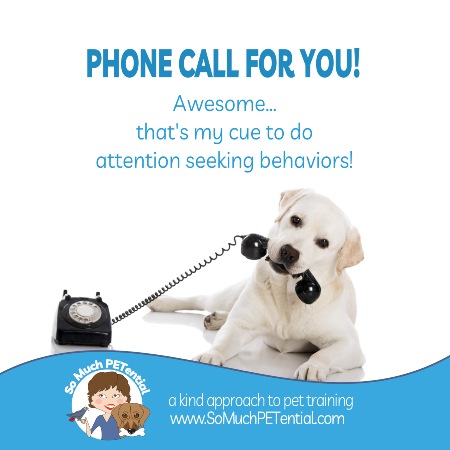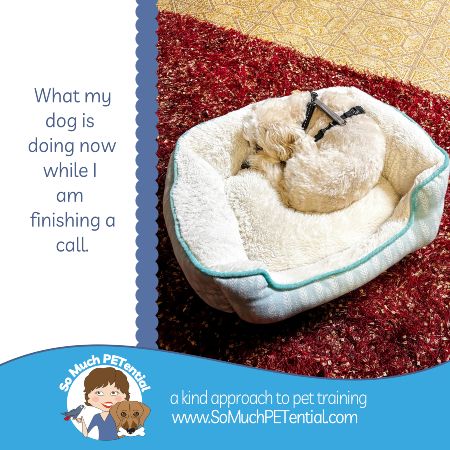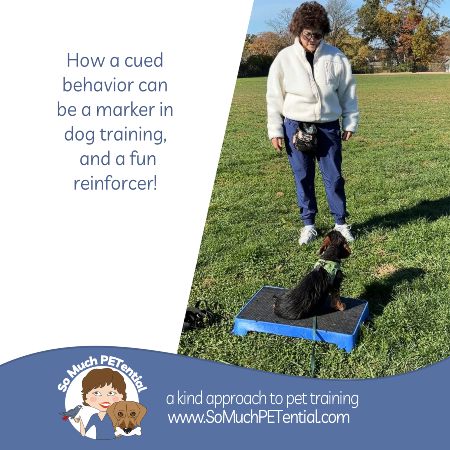Does your dog begin barking or pawing at you, or pacing at your feet as soon as you start a phone call or Zoom meeting? Here are dog training tips for changing your dog’s behaviors…to have better dog manners during your calls.

In my home, I also have an African Grey who likes to interrupt my phone conversations with his own conversation with me. I can share how I respond to Barnaby at the end. 😊
To Solve This Dog Behavior Problem, Remember This: Cues and Consequences Matter
ALL behavior happens for a reason. It is a tool all of us use to get more of what we value, whether that is distance from something we find aversive or an opportunity for something that brings us pleasure. Dogs and birds use behavior in the same way.
Looking at behavior through the lens of seeing it from the animal’s perspective – what happened after the behavior (the consequence) and what happened in the environment to set the stage for that animal to act (antecedents), will unlock the secret behind why behaviors continue or do not continue. This is called Applied Behavior Analysis.
Enough of the scientific jargon. Let’s just take a look at the specific set of attention seeking behaviors that occur when you begin talking on the phone or in a Zoom meeting.
What Is Training Your Dog To Do Attention Seeking Behaviors?
Well, in all honesty, you are. You AND your response to your dog’s attention seeking behaviors at that time.
I am willing to bet that, if your dog barks, paws at you, or paces at your feet when you are talking, that you give your dog attention, likely also a toy, treat or chew.
Pretty awesome from your dog’s point of view! Seeing as your dog is a pretty smart boy or girl, he/she knows just when to bark, paw or pace to get attention, a toy, a treat, a chew or BINGO, all of the above!
It is those immediate consequences that are the driving force behind your dog’s poor phone etiquette.
While the consequences are what is giving those poor phone etiquette behaviors value, and reason to continue doing them; the antecedents are what tell your dog WHEN to do those behaviors to seek the awesome consequences.
Antecedents of Behavior are Cues for Doing Behavior
Antecedents (also called discriminative stimulus or cues) are like green lights that tell the animal when to go in order to achieve a result (or consequence).
Cues can be intentional as in dog training. We use antecedents all the time in dog training. The word SIT means, NOW is the time to put your rear end down TO GET a positive outcome such as a door to open or an opportunity to play or greet someone. For my dog, the word HERE said in loud, happy tone, means NOW is the time to get to me as fast as your legs can carry you, TO GET a treat scatter.
Cues can also come from the environment.
You walking to the kitchen at around 5:00 pm is an environmental or contextual cue that tells your dog NOW is the time to bark, run in circles, jump because apparently those behaviors cause food to appear in your dog’s bowl. (Since the filled food bowl happens after those behaviors.)
Hearing the garage door open is your dog’s cue for barking, jumping, running back and forth, because those behaviors at that time apparently get family members to walk through the door.
How brilliant of your dog to figure this out!
Here is another way of looking at this. You walking with your dog to the front door can either be a cue for your dog to jump and bark or it can be a cue for your dog to lay down on a mat, in order to get the door to open. Both cues are the same and both outcomes are the same. What behaviors you are seeing in your dog is a matter of what you teach your dog to do in that context, to get the consequence your dog wants.
Training Your Dog To Have Better Phone Etiquette
Ok, now let’s circle back to the original problem.
There are many ways you can choose to address this. Below are some ideas.
Antecedent Arrangement
This involves making changes that cause the undesirable behavior to be less likely or not possible at all, so that you can make the desirable behavior easier to do.
Some tips for putting antecedent arrangement into practice:
- Give your dog a chew stick or toy BEFORE the attention seeking behaviors begin
- Put your dog outside or in his crate prior to your Zoom or phone call
- Use a wireless phone so that you can move away from your dog
Training Your Dog
One way of solving this is to train your dog to relax on his bed and then making your holding the phone a cue for his doing that behavior. If you would like your phone holding to be a cue for your dog to relax on his bed,

- First teach your dog the behavior or relaxing on his bed.
- Add a cue to that behavior (such as a word or finger pointing)
- When your dog does this fluently, THEN, pick up the phone JUST BEFORE cueing your dog to
to relax on his bed. Practice this over and over. - Begin pausing between picking up your phone and cueing your dog to relax on his bed.
- Only practice for 15 repetitions. Stop. Come back later.
- You may need to go back steps when you start again but you will move past the steps more quickly. Again only practice about 15 repetitions and stop.
- Begin adding a longer pause. Your dog may begin relaxing on his bed when you pick up the phone, in anticipation of your cueing the behavior.
For me, I use this antecedent arrangement when I am working at my desk…I take a break every 1.5 hours and do either (or all) play with, practice training games, or take my dog outside. This helps him to be able to settle while I work. There are times when admittedly I let Dawson sit on my lap for a little of my Zoom calls. For dog training Zoom calls, he is often in his crate.
About My African Grey
My talking on the telephone is often Barnaby’s cue to begin his conversations with me. I have to admit, many people find it cute on the other end of the phone so I end up reinforcing his talking behavior. (I think it is cute too.) On days when I do not want him joining in on the call, I will make sure he has refreshed activities in his cage or will take the call in my basement.






